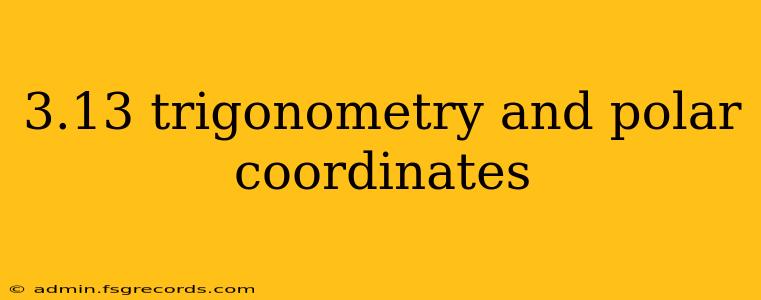Trigonometry and polar coordinates are fundamental concepts in mathematics, finding widespread applications in various fields like physics, engineering, and computer graphics. This detailed exploration delves into the core principles, relationships, and practical applications of these interconnected mathematical tools. We'll move beyond basic definitions to explore their power and versatility.
Understanding Trigonometry's Role in Polar Coordinates
Before diving into the specifics of polar coordinates, let's refresh our understanding of the trigonometric functions: sine, cosine, and tangent. These functions describe the relationships between the angles and sides of a right-angled triangle. In the context of a unit circle (a circle with a radius of 1), the cosine of an angle represents the x-coordinate of the point on the circle, and the sine represents the y-coordinate. This connection is crucial for understanding how trigonometry underpins polar coordinates.
The Essence of Trigonometric Functions:
- Sine (sin θ): The ratio of the length of the side opposite the angle θ to the length of the hypotenuse.
- Cosine (cos θ): The ratio of the length of the side adjacent to the angle θ to the length of the hypotenuse.
- Tangent (tan θ): The ratio of the sine to the cosine (opposite side to adjacent side).
Polar Coordinates: An Alternative Coordinate System
While the familiar Cartesian coordinate system uses x and y coordinates to locate points on a plane, polar coordinates offer a different perspective. Instead of using perpendicular distances from two axes, polar coordinates utilize a distance (radius, r) from the origin and an angle (θ) measured counter-clockwise from the positive x-axis. This system is particularly useful when dealing with circular or rotational phenomena.
Defining Polar Coordinates:
A point in polar coordinates is represented as (r, θ), where:
- r: Represents the radial distance from the origin (always non-negative).
- θ: Represents the angle (in radians or degrees) measured counter-clockwise from the positive x-axis.
The Interplay Between Cartesian and Polar Coordinates
The beauty of polar coordinates lies in their seamless conversion to and from Cartesian coordinates. This interoperability allows us to leverage the strengths of both systems depending on the problem at hand.
Conversion Formulas:
-
Cartesian to Polar:
- r = √(x² + y²)
- θ = arctan(y/x) (Note: Consider the quadrant to determine the correct angle)
-
Polar to Cartesian:
- x = r cos θ
- y = r sin θ
Applications of Trigonometry and Polar Coordinates
The combined power of trigonometry and polar coordinates is evident in a wide range of applications:
1. Navigation and GPS:
Polar coordinates are ideal for representing locations based on distance and bearing from a reference point. This is fundamental to GPS technology and navigational systems.
2. Robotics and Automation:
Describing the position and orientation of robotic arms and other mechanisms often utilizes polar coordinates for efficient control and path planning.
3. Physics and Engineering:
Many physical phenomena, such as circular motion, wave propagation, and projectile trajectories, are most easily described and analyzed using polar coordinates.
4. Computer Graphics:
Polar coordinates are heavily used in computer graphics for creating and manipulating circular shapes, spirals, and other curves.
Advanced Concepts and Further Exploration
This exploration provides a foundational understanding of trigonometry and polar coordinates. For a deeper dive, consider exploring topics like:
- Complex Numbers in Polar Form: Representing complex numbers using polar coordinates simplifies many operations.
- Polar Equations: Equations expressed in polar coordinates can generate fascinating curves.
- Calculus in Polar Coordinates: Extending calculus concepts to polar coordinates opens new avenues for problem-solving.
By understanding the fundamental relationship between trigonometry and polar coordinates and their diverse applications, you'll gain a powerful toolkit for tackling a wide array of mathematical and real-world problems. This interdisciplinary approach highlights the elegance and practicality of these mathematical concepts.

